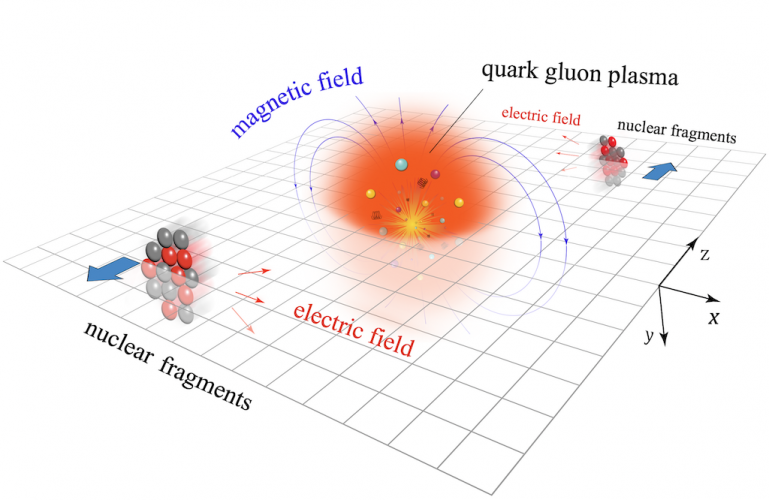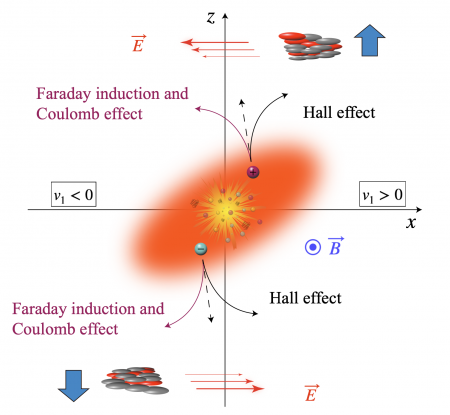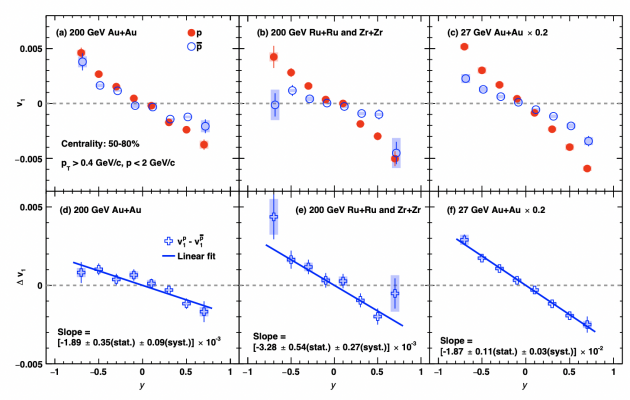Paper home page of probing EM-field by v1
Paper v8.1: https://drupal.star.bnl.gov/STAR/system/files/main_16.pdf
responses: https://drupal.star.bnl.gov/STAR/system/files/Responses_round2.pdf
PRX report and responses: round 1
Paper v7.1: https://drupal.star.bnl.gov/STAR/system/files/Manuscript_v7.1.pdf
responses: https://drupal.star.bnl.gov/STAR/system/files/Replies_to_editor_v4.pdf
Paper v6.1: https://drupal.star.bnl.gov/STAR/system/files/GPC337_paper6.1.pdf
Paper draft v6: drupal.star.bnl.gov/STAR/system/files/Observation_of_the_electromagnetic_effect_via_charge_dependent_directed_flow_in_Au_Au_Ru_Ru_and_Zr_Zr_collisions_at__200_GeV.pdf
Reply to Collaboration Review and new draft (sent to star-paper list)
Paper draft v5.1: https://drupal.star.bnl.gov/STAR/system/files/GPC337_paper_v5.1.pdf
Reply: https://drupal.star.bnl.gov/STAR/system/files/Reply%20to%20collaboration%20review.pdf
Reply to Collaboration Review and new draft (sent to GPC)
Paper draft v5: https://drupal.star.bnl.gov/STAR/system/files/GPC337_paper_v5.pdf
Reply: https://drupal.star.bnl.gov/STAR/system/files/Reply%20to%20collaboration%20review%20.pdf
Collaboration Review:
Paper draft v4.1: https://drupal.star.bnl.gov/STAR/system/files/GPC337_paper_v4.1.pdf
GPC337 (Aug 9, 2022)
Notes and response: https://drupal.star.bnl.gov/STAR/system/files/Reply%20to%20GPC%20Aug%209%202022.pdf
paper draft v4: https://drupal.star.bnl.gov/STAR/system/files/GPC337_paper_v4.pdf
GPC337 (Aug 3, 2022)
Notes and response: drupal.star.bnl.gov/STAR/system/files/Reply%20to%20GPC337%20Aug%203%20_2.pdf
paper draft v3: drupal.star.bnl.gov/STAR/system/files/GPC337_paper_v3.pdf
GPC337 (July 6, 2022)
Notes and response: https://drupal.star.bnl.gov/STAR/system/files/Response%20to%20the%20comments%20from%20GPC%20337%20meeting%20on%20July%206%202022.pdf
paper draft v2: https://drupal.star.bnl.gov/STAR/system/files/GPC337_paper_v2.pdf
PWGC review: https://drupal.star.bnl.gov/STAR/system/files/PWGC_0.pdf
Replies to PWGC: https://drupal.star.bnl.gov/STAR/system/files/RepliesToPWGC.pdf
PWG Presentations:
- https://drupal.star.bnl.gov/STAR/system/files/Charge%20dependent%20v1%20of%20pion.pdf
- https://drupal.star.bnl.gov/STAR/system/files/FCV-Jun23.pdf
- https://drupal.star.bnl.gov/STAR/system/files/FCV-Aug25.pdf
- https://drupal.star.bnl.gov/STAR/system/files/Updates%20and%20paper%20proposal%20-Oct13%202021.pdf
- https://drupal.star.bnl.gov/STAR/blog/dshen/Updates-efficiencies
- https://drupal.star.bnl.gov/STAR/system/files/CollaborationMeeting-Sep16.pdf
- https://drupal.star.bnl.gov/STAR/system/files/CollaborationMeeting-plenary-v2.pdf
- https://drupal.star.bnl.gov/STAR/system/files/Isobar_v1_STAR_meeting.pdf
- https://drupal.star.bnl.gov/STAR/system/files/v1_isobar_IMP_group_Aug25_2021_0.pdf
- https://drupal.star.bnl.gov/STAR/system/files/v1_isobar_IMP_group_Mar24_2021.pdf
- https://drupal.star.bnl.gov/STAR/system/files/paper%20proposal%20II.pdf
- https://drupal.star.bnl.gov/STAR/system/files/Updates%20on%20paper%20proposal%20II.pdf
- https://drupal.star.bnl.gov/STAR/system/files/Pwg_presentation_Nov2_2022_Aditya.pdf
- https://drupal.star.bnl.gov/STAR/system/files/Oct24_update4STARReview.pdf
Paper draft(v1): https://drupal.star.bnl.gov/STAR/system/files/Observation_of_the_electromagnetic_effect_via_charge_dependent_directed_flow_in_Au_Au_Ru_Ru_and_Zr_Zr_collisions_at__200_GeV_0.pdf
Analysis note: https://drupal.star.bnl.gov/STAR/starnotes/private/PSN0791
Code: $CVSROOT/offline/paper/psn0791
Observation of the electromagnetic field effect via charge-dependent directed flow in heavy-ion collisions at the Relativistic Heavy Ion Collider
Target journal: Physical Review X
Figures:
 Figure 1
Figure 1Fig 1: Sketch of a heavy-ion collision. The impact parameter and the beam direction are along the $x$ and $z$ axes, respectively. The $x$-$z$ plane is called the reaction plane. Participating nucleons in the overlap region create a hot and dense medium of quark-gluon plasma. Spectator nuclear fragments generate strong electromagnetic fields.

Fig 2: Schematic side view of a heavy-ion collision. The dashed lines represent the motion of quarks due to the QGP expansion.The black solid lines indicate the Hall effect, where the magnetic field exerts the Lorentz force on moving charges. The impact of the Coulomb field from spectators and the Faraday field induced by the fast decay of the magnetic field is marked by red lines.

Fig 3: Illustration of different contributions to $\Delta(dv_1/dy)$ between protons and anti-protons versus centrality. Panel (a) sketches the transported-quark effect. Panel (b) depicts the electromagnetic-field

 Figure4b
Figure4b
Fig 4: Panel (a): the ionization energy loss $dE/dx$ of charged particles as a function of momentum in TPC. The solid lines are the corresponding Bichsel function. Panel (b): the mass-squared as a function of momentum in TOF. The dashed boxed areas indicate the pion, kaon and proton candidates.

Fig 5: $v_1$ for protons and anti-protons as a function of rapidity in (a) Au+Au collisions at $\sqrt{s_{NN}}=$ 200 GeV, (b) isobar (Ru+Ru and Zr+Zr) collisions at $\sqrt{s_{NN}}=$ 200 GeV, and (c) Au+Au collisions at $\sqrt{s_{NN}}=$ 27 GeV in the centrality interval of 50--80\%. Protons and anti-protons are marked with solid and open circles, respectively. Panels (d), (e) and (f) show $\Delta v_1 \equiv v_1^{p} - v_1^{\bar{p}}$ versus rapidity. The $d\Delta v_1/d\mathsf{y}$ values are obtained with linear fits (solid lines). Systematic uncertainties are indicated with shaded bands.

Fig 6: The $\Delta v_1$ slope, $\Delta dv_1/dy$, between positively charged and negatively charged pion, kaon and proton as a function of centrality in (a) Au+Au collisions and (b) Ru+Ru and Zr+Zr collisions at $\sqrt{s_{NN}}=$ 200 GeV. Slopes are obtained by fitting $\Delta v_1$ in -0.8 $<y<$ 0.8 with a linear function. Different open markers are used to indicate experimental measurement, and a blue solid line stands for theoretical prediction on $v_1$ splitting of proton induced by electromagnetic field effect in the transverse momentum range of 1 $<p_T<$ 2 GeV/c, in Au+Au collisions at $\sqrt{s_{NN}}=$ 200 GeV\cite{Gursoy:2018yai}. The shaded bands indicate systematic uncertainties. For visual coherence, the predictions are scaled by a factor of 0.5.
Conclusions:
- dshen's blog
- Login or register to post comments
